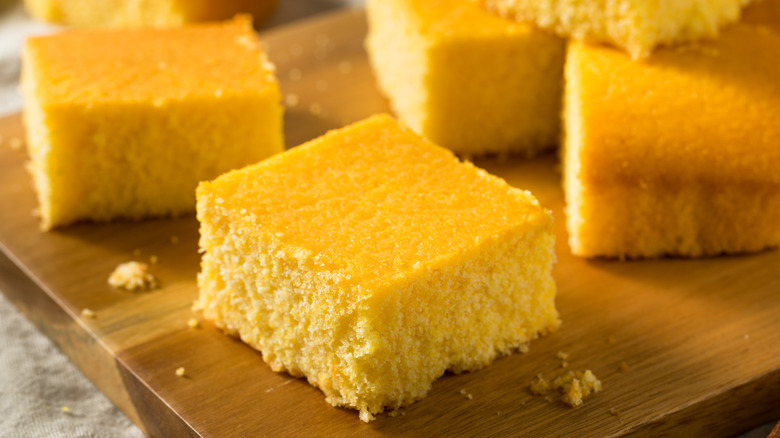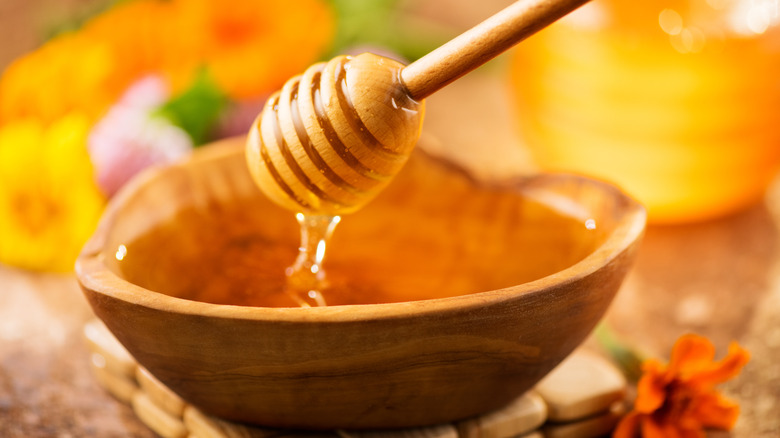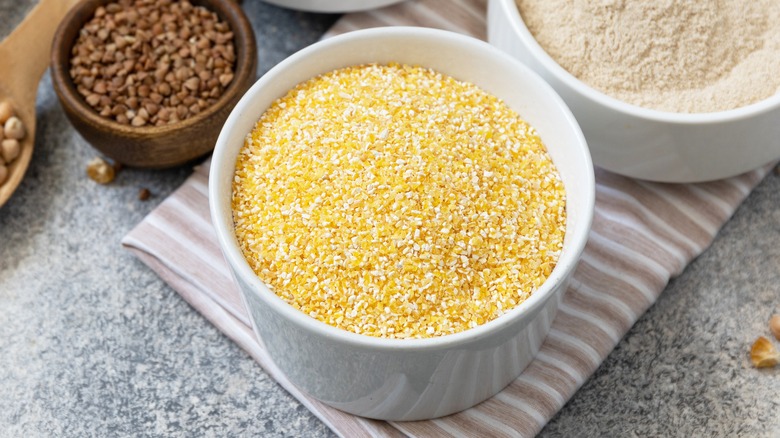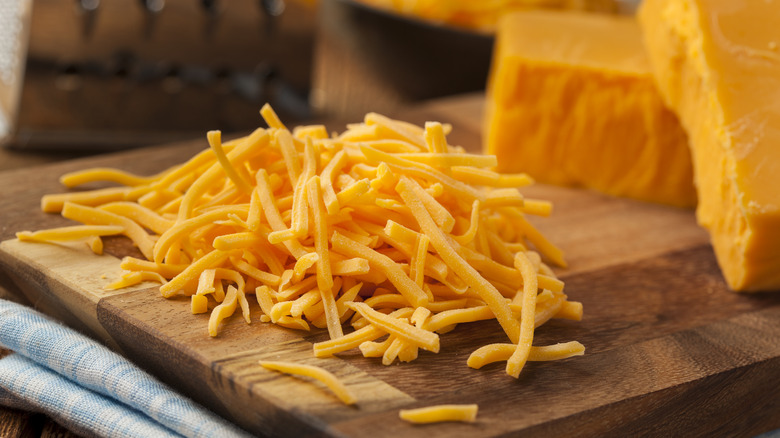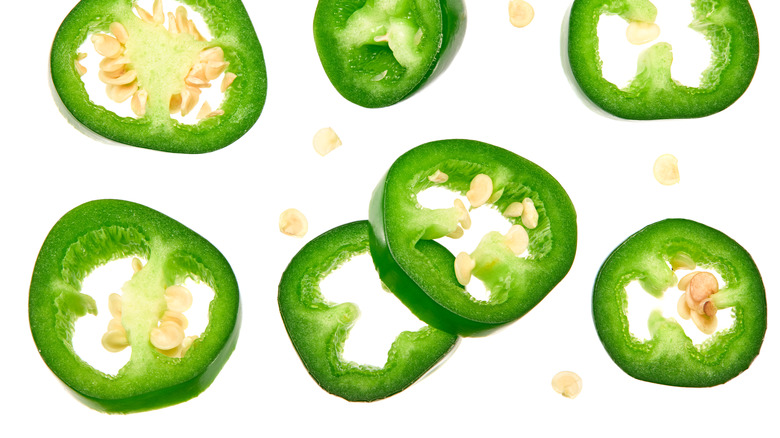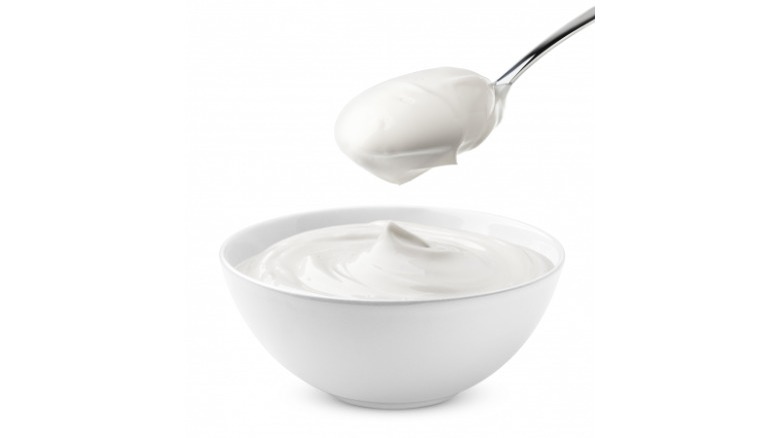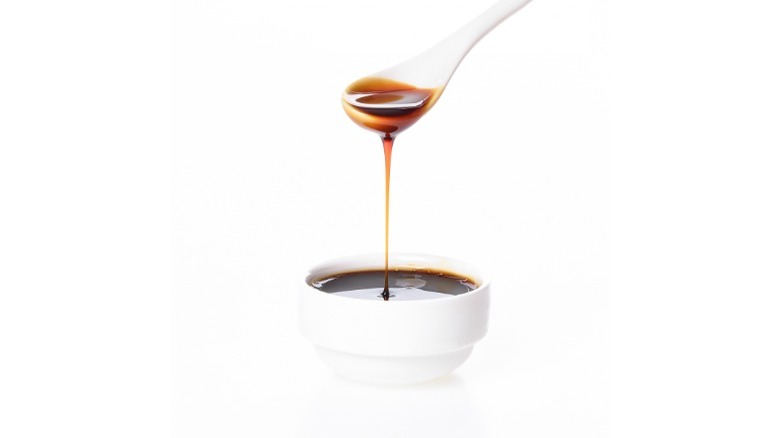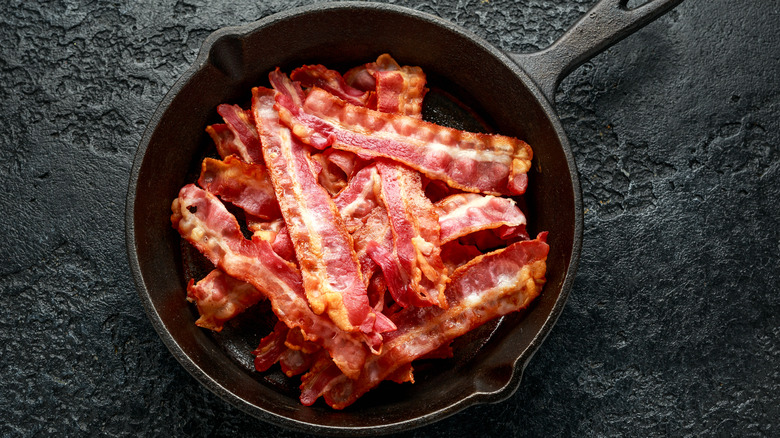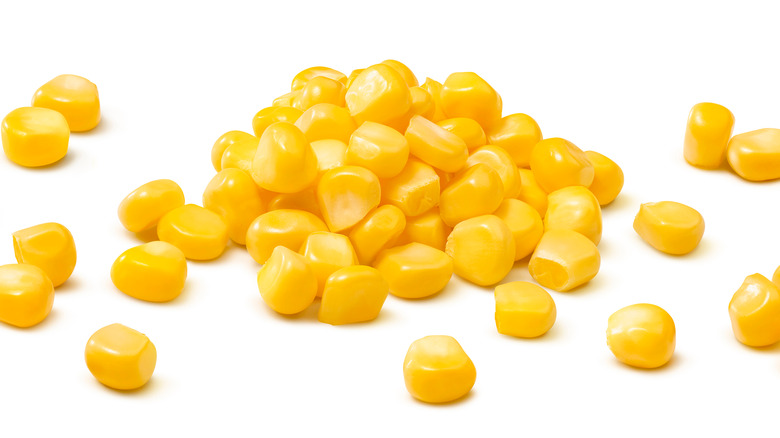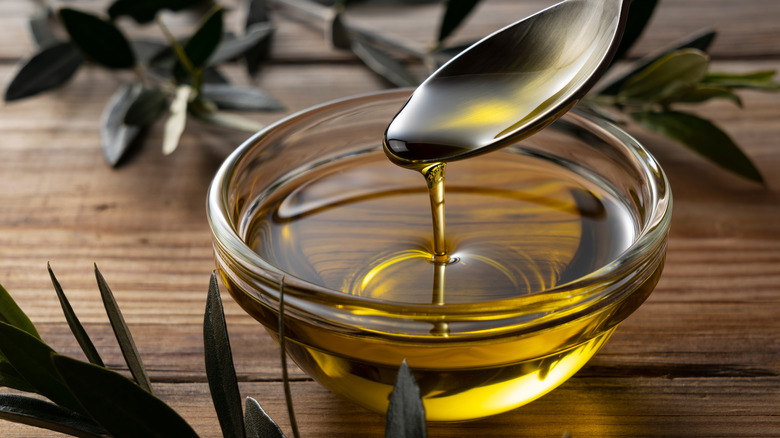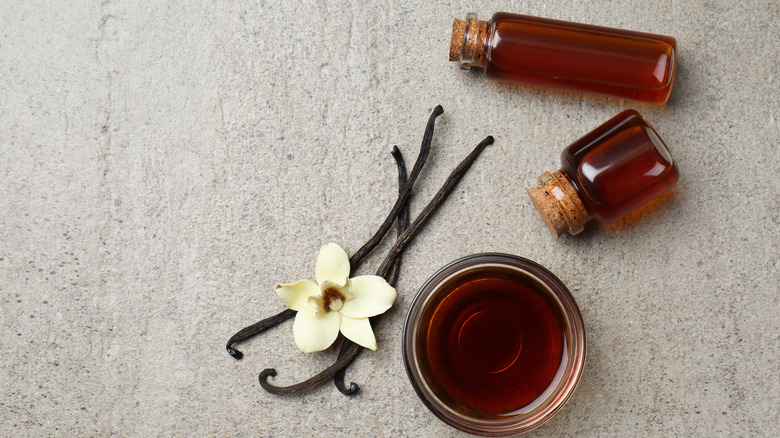10 Ingredients That Will Seriously Upgrade Cornbread
Cornbread has been made for hundreds of years and started out as a dish made by Native Americans. However, these original cornbread products looked different from the quick bread we know today. Instead, it was made from a corn flour base, which was formed into a ball and boiled (via Oneida Nation).
Cornbread began to evolve with the introduction of Western colonizers. Enslaved Africans, who had previously been introduced to corn, made baked cornbread with the ingredients they had (via Essence). During the American Civil War, cornbread took on new popularity with the introduction of baking soda as a leavener (via Pine Straw Magazine). Today's cornbread is light and fluffy, is oftentimes sweetened more than that of its predecessors, and is undoubtedly an American food.
Its simple recipe and delicious, comforting nature make cornbread one of the best foods to have as a side dish or as a delightful breakfast treat. Just because it is easy to make, though, doesn't mean it has to be boring. With some easy upgrades, you can take your cornbread from ordinary to extraordinary, leaving you and any guests wanting more.
1. Honey
Honey butter is one of the best toppings for cornbread. This creamy spread adds both moisture and a touch of sweetness to the naturally slightly gritty bread. So why not cut out the middleman and add honey directly to your cornbread?
Recipes for moist honey cornbread muffins include both honey and butter in their mix. Making honey cornbread means not only do you end up with a loaf of sweet bread, but the honey also adds extra moisture to the bread. As honey company Manuka Corner explains, honey has a higher moisture content than sugar. Honey is also a good bit sweeter than sugar, so if swapping for sugar, Manuka Corner recommends using only about half to two thirds the amount of honey as sugar.
The end result will be an elevated cornbread that is a little chewier and has a hint of that lovely honey flavor. However, do not worry about it getting too sweet; if substituted for sugar appropriately, honey cornbread will still pair perfectly with a savory chili as a side dish or topped with even more honey butter.
2. Stone-ground corn
It may sound rudimentary, but one of the best ways to upgrade your cornbread is to upgrade the ingredients used to make it. Of course, the most important essential ingredient is corn or, more specifically, ground cornmeal.
Sure, you can run to the store and grab any old container of cornmeal, but that will give you just a run-of-the-mill, ordinary, and, dare we say, boring cornbread. Instead, Chef Sara Moulton recommends putting a little more thought into it. According to Moulton, the typical cornmeal found in grocery stores is medium-grind cornmeal that was ground with steel. It typically comes in yellow color and does not have much variation. However, now you can find a whole world of different cornmeal on the market.
Bob's Red Mill, for example, makes a coarse-grind stone-ground cornmeal. The larger grind will give a more distinct texture to the cornbread. Moulton points out that in addition to the texture, stone-ground cornmeal has a more prominent flavor.
For those looking to take it one step further, companies such as Marsh Hen Mill make a selection of heirloom varieties of stone-ground cornmeal. Each variety comes with its own unique flavor profile and color. Their Unicorn Cornmeal, for example, has a pink hue and offers a sweet flavor. This will really make your cornbread stand out in the crowd.
3. Cheddar cheese
What doesn't taste better with cheese, really? If you want to punch up the flavor of your cornbread, try adding cheese — but not just any cheese. Add America's favorite cheese, cheddar (via YouGov America).
It is no wonder that cheddar is so popular. There are lots of different types of cheddar you can add to cornbread, each of which will bring its own flavor profile. According to Wisconsin Cheese, a young cheddar will offer a mild and creamy flavor and soft texture. Aged cheddar, on the other hand, has a sharp, poignant flavor and tends to be more crumbly. Cheddar cheese naturally has a pale beige color but often has an orange color added to it.
Whatever your preference, adding cheddar cheese to your cornbread will give it a pop of flavor and color. Picking up a pack of shredded cheddar from the grocery store makes an easy adaption to any recipe.
4. Peppers
When you want to spice things up, there is really only one option: peppers! Peppers make a colorful and flavorful upgrade to any cornbread.
If you are looking for heat, jalapenos are a great choice. This cast-iron jalapeño cornbread recipe uses spicy pepper to add texture and heat. If you want more spice, leave the seeds in; for less spice, make sure to remove the seeds from the peppers before dicing. But why limit yourself to just one pepper? Mashed's cheesy Mexican cornbread recipe utilizes both fresh jalapeños and canned green chile peppers. This will bring a breadth of flavor.
If you want to add depth but are not someone who enjoys much spicy food, why not try diced bell peppers or poblano peppers? Both are mild but bring their own peppery flavor to the mix. Then, to kick it up a notch further, try using diced roasted peppers for a sweet and smoky aroma without the spice of hot peppers.
No matter what your preference, there is a pepper out there just waiting to be added to your next batch of cornbread.
5. Sour cream or buttermilk
Milk is a perfectly fine ingredient to use when making cornbread. It does the trick by adding liquid and fat. But you don't just want adequate cornbread; you want fantastic cornbread. That is why you should be using sour cream or buttermilk in your cornbread instead of just plain milk.
Chef Eddy Van Damme explained to Imperial Sugar that regular milk creates a drying and subpar final product. But since buttermilk and sour cream are both fermented dairy products, they contain acids that help to prevent long gluten bonds from forming in baked goods, creating a softer, crumbly product. Sour cream also offers a notable tang and has a higher fat content than buttermilk. This creates a distinct flavor and a more moist end result.
If you find yourself without either in the kitchen, buttermilk is easy to make at home by simply adding vinegar or lemon juice to your milk and letting it sit for a few minutes. If you do have both in your house, why not make the most of it and try Mark Steuer's cornbread recipe, which utilizes both sour cream and buttermilk?
6. Molasses
If you want to add an historical bent to your cornbread, try adding molasses. As food historian Michael Twitty told The Charlotte Observer, classic Southern cornbread was not sweet and definitely did not use sugar. Instead, Twitty explains, they used molasses, which was cheaper and added iron to the dish.
Molasses is a sugar by-product made during the refining of sugar cane. It is deep in color, and while it is sweet, it offers a bit of a harsh, earthy, and metallic flavor. Molasses is sometimes added back into white sugar to create brown sugar.
If you are hesitant to go all in on a full molasses cornbread, try subbing the white sugar called for in the recipe for either light or dark brown sugar. Alternatively, you can add 1-2 tablespoons of molasses per cup of sugar to the recipe (via Healthline). Finally, if you are looking for a more robust molasses flavor, try entirely swapping out the sugar for molasses. According to King Arthur Baking Company, sugar to molasses is a 1-1 swap.
7. Bacon and bacon drippings
Another blast from the past here to improve your cornbread is bacon, or more specifically, bacon drippings. According to Pine Straw Magazine, baking soda became available in North America during the Civil War, which helped transform cornbread into a style similar to what we know today. As a result, the bread became more popular, and one of the prominent ways of cooking it was by frying the batter in a hot cast-iron skillet with bacon drippings, which is the fat that is released from bacon during the cooking process (via MasterClass).
Bacon drippings are not just fatty; they are flavorful, too. Using bacon grease to cook will add a crispy outside and a distinct salty flavor inside. Of course, people will be begging to know what the secret ingredient that makes your cornbread so delicious is.
Bacon's distinct flavor is a genuine crowd-pleaser, so don't just stop at bacon drippings. Instead, go whole hog and add bacon to the cornbread itself to create a sweet and salty masterpiece. Take a page out of the history book and cook your bacon in a cast-iron skillet — and then use both the bacon-dripped pan and the bacon to make the cornbread. The end result does not add to the dirty dishes but does add to the flavor.
8. Corn
Of course, there is corn in cornbread. However, a basic cornbread typically uses just cornmeal, a product made from grinding corn, as its base. We already discussed how using different types of cornmeal can upgrade your cornbread, but to take matters even further, why not add in more corn in a different form? Not only will this increase the corn flavor, but it can improve the texture and make the final product more interesting and pleasing.
Adding corn to cornbread does not have to be difficult. An easy way to do this is to get a can of creamed corn for your recipe. This will add small pieces of corn as well as a creamy base which will produce a rich and sweet cornbread.
You can also use fresh or frozen corn and lightly puree it. This will once again add moisture and texture to the cornbread to really elevate your cornbread without altering the corn flavor.
9. Olive oil
For those looking to upgrade their cornbread in a way that feels both elevates the flavor and does not prevent it from being paired with other foods, olive oil is the answer. Many cornbread recipes call for either melted butter or vegetable oil. While this gives a somewhat natural flavor, swapping it for the more distinct flavor of olive oil will bring a more sophisticated and subtle earthy flavor. According to LiveStrong, it will also offer a crisp crust, which will add a lovely texture. If you are hesitant, remember that bread such as focaccia prominently features olive oil for flavor and texture. Now you can bring this all to your cornbread.
Additionally, as LiveStrong points out, olive oil has particular health benefits in it as well. Olive oil has been known for lowering cholesterol and makes a great alternative to other oils. While the price of olive oil tends to be higher than some other oils, it is important to know you do not need to use the expensive extra-virgin-style olive oils. Light olive oil is both cheaper and has a higher smoke point, making it better for baking (via North American Olive Oil Association). No matter which olive oil you choose, though, you are sure to end up with a sophisticated-tasting cornbread.
10. Vanilla extract
Cornbread has evolved from its Native American roots. Prior to the American Civil War, sweetened cornbread was not as popular (via The Charlotte Observer). Now, however, sweeter cornbread has become the culinary standard. One of the best ways to enhance and play off this sweetness is to add vanilla extract.
As HuffPost explains, vanilla acts as a complement and natural flavor enhancer to corn's natural sweetness. Bobbie Lloyd, chief baking officer of noted New York City bakery Magnolia Bakery, explains to HuffPost that "vanilla is like salt," in that it works to bump up the flavors around it and is not necessarily the prominent flavor itself. This statement was supported by Chef John Demetrios from Oaxen Krog, a 2-Michelin Star restaurant located in Stockholm.
The goal when adding vanilla to a sweeter dish such as cornbread is not to make the dish have a prominent vanilla taste, which, while delicious, will not pair well with certain other flavors. Instead, it is to use just enough to punch up the natural sweetness of the corn and the added sugar. Adding vanilla extract will make a heavenly cornbread filled with a delicate yet noticeable flavor.
